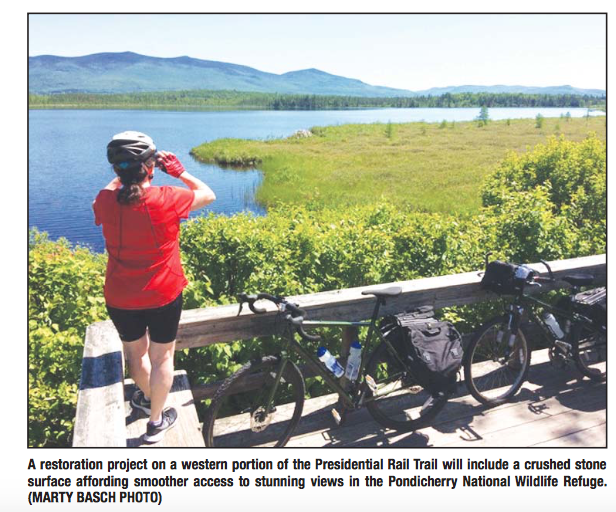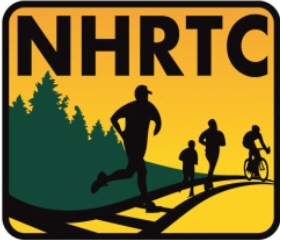
Source:
Part of Presidential Rail Trail to get crushed stone surface.
Marty Basch
Jul 8, 2020
A western portion of the Presidential Rail Trail in the beloved Pondicherry National Wildlife Refuge is undergoing restoration that when complete will see a crushed stone surface. The slice of the trail in Whitefield and Jefferson, well-frequented by bikers, birders and walkers, will also see work that includes better drainage and culverts, trailhead improvements on Airport Road and Route 115A and the installation of four Beaver Deceivers designed to prevent beavers from blocking culverts and flooding the trail which happens repeatedly. According to Friends of Pondicherry Volunteer Coordinator David Govatski of Jefferson, restoration on the Pondicherry Rail Trail, which is a portion of both the Presidential Rail Trail and the Cross New Hampshire Adventure Trail, started June 1.
Most of the work is expected to be completed by the end of July. Signs are posted warning of construction and people can still use the trail after getting the OK from the excavator operator. The socially distant work is done on weekdays. He says the Pondicherry Rail Trail is 1.6 miles long from Whitefield’s Airport Road to Cherry Pond in Jefferson and is part of the longer Presidential Rail Trail that goes to Gorham. “The two rail trails were acquired at different times, hence the name difference, but for practical purposes is just a section of the PRT,” he wrote during email exchanges. “The entire length of restoration work is that first 1.6 miles to Cherry Pond, then 2.4 miles to Route 115A in Jefferson.” The work coincides with the 150th anniversary of the John’s River Logging Railroad built in 1870 and considered to be the first in the White Mountains. “This logging railroad reached Cherry Pond from Whitefield in 1870, and we are now working on this historic section of early railroad,” said the retired forester. “This logging railroad later became the Whitefield and Jefferson Railroad, and finally the Boston and Maine Railroad.” According to Govatski, one of the most important parts of the work being done by the New Hampshire Bureau of Trails with funding provided by a federal program is putting a crown on the finished trail surface.
“This allows the water to run off to the sides, where the restored drainage ditches, and new culverts will remove the water and prevent puddling. The crown is almost imperceptible but is a vital feature of trails or roads,” he says. The ledge pack surface is three-eighth-inch crushed rock. The depth will be 4 inches with a width of 8 feet. “It makes for a great bicycle riding, walking and wheelchair surfacing material,” he says. Not bad for driveways, too. The construction also includes improvements to a 40-foot side trail leading to a temporary overlook created on land owned by the town of Whitefield in 2018 that includes a northwest view to the Mount Washington Regional Airport. After receiving complaints about the unsightly clearcut, Govatski installed a bench built by Whitefield volunteer Dick Mallion. Now that a culvert and fill’s in, no one’s complaining, and birders have seen a mourning warbler, uncommon to such habitat. “This view will last maybe 10 years, and I expect that we will hear complaints about not keeping the view open,” he says.
